Modeling Hydrodynamic Charge Transport in Graphene
Abstract
:1. Introduction
2. Theory and Methods
2.1. Nonlinear Electrostatic Approach: Modeling Gating and Contact Doping
2.2. Hydrodynamic Charge Transport in Graphene
2.2.1. Hydrodynamic Transport Model
2.2.2. Graphene Properties and Parameters
3. Results
3.1. Rectification: Tesla Valve
3.2. Poiseuille Flow
4. Discussion
Supplementary Materials
Author Contributions
Funding
Data Availability Statement
Conflicts of Interest
References
- Kong, W.; Kum, H.; Bae, S.-H.; Shim, J.; Kim, H.; Kong, L.; Meng, Y.; Wang, K.; Kim, C.; Kim, J. Path towards graphene commercialization from lab to market. Nat. Nanotechnol. 2019, 14, 927–938. [Google Scholar] [CrossRef]
- Akinwande, D.; Huyghebaert, C.; Wang, C.-H.; Serna, M.I.; Goossens, S.; Li, L.-J.; Wong, H.-S.P.; Koppens, F.H. Graphene and two-dimensional materials for silicon technology. Nature 2019, 573, 507–518. [Google Scholar] [CrossRef]
- Cao, Y.; Fatemi, V.; Fang, S.; Watanabe, K.; Taniguchi, T.; Kaxiras, E.; Jarillo-Herrero, P. Unconventional superconductivity in magic-angle graphene superlattices. Nature 2018, 556, 43–50. [Google Scholar] [CrossRef]
- Hao, Z.; Zimmerman, A.; Ledwith, P.; Khalaf, E.; Najafabadi, D.H.; Watanabe, K.; Taniguchi, T.; Vishwanath, A.; Kim, P. Electric field–tunable superconductivity in alternating-twist magic-angle trilayer graphene. Science 2021, 371, 1133–1138. [Google Scholar] [CrossRef] [PubMed]
- Huang, T.; Tu, X.; Shen, C.; Zheng, B.; Wang, J.; Wang, H.; Khaliji, K.; Park, S.H.; Liu, Z.; Yang, T.; et al. Observation of chiral and slow plasmons in twisted bilayer graphene. Nature 2022, 605, 63–68. [Google Scholar] [CrossRef] [PubMed]
- Bandurin, D.; Torre, I.; Kumar, R.K.; Shalom, M.B.; Tomadin, A.; Principi, A.; Auton, G.; Khestanova, E.; Novoselov, K.; Grigorieva, I.; et al. Negative local resistance caused by viscous electron backflow in graphene. Science 2016, 351, 1055–1058. [Google Scholar] [CrossRef] [PubMed]
- Kumar, R.K.; Bandurin, D.; Pellegrino, F.; Cao, Y.; Principi, A.; Guo, H.; Auton, G.; Shalom, M.B.; Ponomarenko, L.A.; Falkovich, G.; et al. Superballistic flow of viscous electron fluid through graphene constrictions. Nat. Phys. 2017, 13, 1182–1185. [Google Scholar] [CrossRef]
- Ku, M.J.H.; Zhou, T.X.; Li, Q.; Shin, Y.J.; Shi, J.K.; Burch, C.; Anderson, L.E.; Pierce, A.T.; Xie, Y.; Hamo, A.; et al. Imaging viscous flow of the Dirac fluid in graphene. Nature 2020, 583, 537–541. [Google Scholar] [CrossRef]
- Sulpizio, J.A.; Ella, L.; Rozen, A.; Birkbeck, J.; Perello, D.J.; Dutta, D.; Ben-Shalom, M.; Taniguchi, T.; Watanabe, K.; Holder, T.; et al. Visualizing Poiseuille flow of hydrodynamic electrons. Nature 2019, 576, 75–79. [Google Scholar] [CrossRef]
- Geurs, J.; Kim, Y.; Watanabe, K.; Taniguchi, T.; Moon, P.; Smet, J.H. Rectification by hydrodynamic flow in an encapsulated graphene Tesla valve. arXiv 2020, arXiv:2008.04862. [Google Scholar]
- Nastasi, G.; Romano, V. A full coupled drift-diffusion-Poisson simulation of a GFET. Commun. Nonlinear Sci. Numer. Simul. 2020, 87, 105300. [Google Scholar] [CrossRef]
- Zebrev, G. Graphene field effect transistors: Diffusion-drift theory. In Physics and Applications of Graphene-Theory; Sergey, M., Ed.; IntechOpen: London, UK, 2011; pp. 475–498. [Google Scholar]
- Ancona, M.G. Electron transport in graphene from a diffusion-drift perspective. IEEE Trans. Electron. Devices. 2010, 57, 681–689. [Google Scholar] [CrossRef]
- Champlain, J.G. A first principles theoretical examination of graphene-based field effect transistors. J. Appl. Phys. 2011, 109, 084515. [Google Scholar] [CrossRef]
- Nastasi, G.; Romano, V. An efficient GFET structure. IEEE Trans. Electron. Devices 2021, 68, 4729–4734. [Google Scholar] [CrossRef]
- Mendoza, M.; Herrmann, H.J.; Succi, S. Hydrodynamic model for conductivity in graphene. Sci. Rep. 2013, 3, 1052. [Google Scholar] [CrossRef] [PubMed]
- Chen, Z.; Cockburn, B.; Jerome, J.W.; Shu, C.-W. Mixed-RKDG finite element methods for the 2-D hydrodynamic model for semiconductor device simulation. VLSI Des. 1995, 3, 145–158. [Google Scholar] [CrossRef]
- Gungor, A.C.; Ehrengruber, T.; Smajic, J.; Leuthold, J. Coupled Electromagnetic and Hydrodynamic Modeling for Semiconductors Using DGTD. IEEE Trans. Magn. 2021, 57, 1–5. [Google Scholar] [CrossRef]
- Luca, L.; Romano, V. Quantum corrected hydrodynamic models for charge transport in graphene. Ann. Phys. 2019, 406, 30–53. [Google Scholar] [CrossRef]
- Andrijauskas, T.; Shylau, A.A.; Zozoulenko, I. Thomas–Fermi and Poisson modeling of gate electrostatics in graphene nanoribbon. Lith. J. Phys. 2012, 52, 63–69. [Google Scholar] [CrossRef]
- Liu, M.-H. Gate-induced carrier density modulation in bulk graphene: Theories and electrostatic simulation using Matlab pdetool. J. Comput. Electron. 2013, 12, 188–202. [Google Scholar] [CrossRef]
- Yu, Y.-J.; Zhao, Y.; Ryu, S.; Brus, L.E.; Kim, K.S.; Kim, P. Tuning the graphene work function by electric field effect. Nano Lett. 2009, 9, 3430–3434. [Google Scholar] [CrossRef] [PubMed]
- Gungor, A.; Smajic, J.; Moro, F.; Leuthold, J. Time-domain coupled full Maxwell-and drift-diffusion-solver for simulating scanning microwave microscopy of semiconductors. In Proceedings of the 2019 PhotonIcs & Electromagnetics Research Symposium-Spring (PIERS-Spring), Rome, Italy, 17–20 June 2019; pp. 4071–4077. [Google Scholar]
- Giovannetti, G.; Khomyakov, P.A.; Brocks, G.; Karpan, V.M.; van den Brink, J.; Kelly, P.J. Doping graphene with metal contacts. Phys. Rev. Lett. 2008, 101, 026803. [Google Scholar] [CrossRef] [PubMed]
- Ehrengruber, T.; Gungor, A.C.; Jentner, K.; Smajic, J.; Leuthold, J. Frequency limit of the drift-diffusion-model for semiconductor simulations and its transition to the Boltzmann model. In Proceedings of the 19th Biennial IEEE Conference on Electromagnetic Field Computation (CEFC 2020), Pisa, Italy, 16–18 November 2020; p. 178. [Google Scholar]
- Blotekjaer, K. Transport equations for electrons in two-valley semiconductors. IEEE Trans. Electron Devices 1970, 17, 38–47. [Google Scholar] [CrossRef]
- Aste, A.; Vahldieck, R. Time-domain simulation of the full hydrodynamic model. Int. J. Numer. Model. Electron. Netw. Devices Fields 2003, 16, 161–174. [Google Scholar] [CrossRef]
- Gardner, C.L. Hydrodynamic and Monte Carlo simulation of an electron shock wave in a 1-mu mn/sup+/-nn/sup+/diode. IEEE Trans. Electron. Devices 1993, 40, 455–457. [Google Scholar] [CrossRef]
- Jiang, Z.; Wang, Y.; Chen, L.; Yu, Y.; Yuan, S.; Deng, W.; Wang, R.; Wang, Z.; Yan, Q.; Wu, X.; et al. Antenna-integrated silicon–plasmonic graphene sub-terahertz emitter. APL Photonics 2021, 6, 066102. [Google Scholar] [CrossRef]
- Koepfli, S.M.; Baumann, M.; Giger, S.; Keller, K.; Horst, Y.; Salamin, Y.; Fedoryshyn, Y.; Leuthold, J. High-Speed Graphene Photodetection: 300 GHz is not the Limit. In Proceedings of the 2021 Conference on Lasers and Electro-Optics Europe & European Quantum Electronics Conference (CLEO/Europe-EQEC), Munich, Germany, 21–25 June 2021; p. 1. [Google Scholar]
- Mascali, G.; Romano, V. A hierarchy of macroscopic models for phonon transport in graphene. Phys. A: Stat. Mech. Its Appl. 2020, 548, 124489. [Google Scholar] [CrossRef]
- Ullal, C.K.; Shi, J.; Sundararaman, R. Electron mobility in graphene without invoking the Dirac equation. Am. J. Phys. 2019, 87, 291–295. [Google Scholar] [CrossRef]
- Stauber, T.; Peres, N.M.R.; Guinea, F. Electronic transport in graphene: A semiclassical approach including midgap states. Phys. Rev. B 2007, 76, 205423. [Google Scholar] [CrossRef]
- Berdebes, D.; Low, T.; Lundstrom, M.; Center, B.N. Low bias transport in graphene: An introduction. NCN@ Purdue Summer School: Electronics from the Bottom Up 2009. Available online: https://www.researchgate.net/profile/Ms-Lundstrom/publication/242088422_Low_Bias_Transport_in_Graphene_An_Introduction/links/00b4953b4ad625d391000000/Low-Bias-Transport-in-Graphene-An-Introduction.pdf (accessed on 1 September 2021).
- Meric, I.; Han, M.Y.; Young, A.F.; Ozyilmaz, B.; Kim, P.; Shepard, K.L. Current saturation in zero-bandgap, top-gated graphene field-effect transistors. Nat. Nanotechnol. 2008, 3, 654–659. [Google Scholar] [CrossRef]
- Chauhan, J.; Guo, J. High-field transport and velocity saturation in graphene. Appl. Phys. Lett. 2009, 95, 023120. [Google Scholar] [CrossRef]
- Baker, A.M.R.; Alexander-Webber, J.A.; Altebaeumer, T.; Nicholas, R.J. Energy relaxation for hot Dirac fermions in graphene and breakdown of the quantum Hall effect. Phys. Rev. B 2012, 85, 115403. [Google Scholar] [CrossRef]
- Dong, H.; Xu, W.; Tan, R. Temperature relaxation and energy loss of hot carriers in graphene. Solid State Commun. 2010, 150, 1770–1773. [Google Scholar] [CrossRef]
- Tesla, N. Valvular Conduit. U.S. Patent 1329559A, 3 February 1920. [Google Scholar]
- Han, M.Y.; Kim, P. Graphene nanoribbon devices at high bias. Nano Converg. 2014, 1, 1–11. [Google Scholar] [CrossRef] [PubMed]
- Maffucci, A.; Miano, G. Number of conducting channels for armchair and zig-zag graphene nanoribbon interconnects. IEEE Trans. Nanotechnol. 2013, 12, 817–823. [Google Scholar] [CrossRef]
- Cockburn, B.; Shu, C.-W. Runge–Kutta discontinuous Galerkin methods for convection-dominated problems. J. Sci. Comput. 2001, 16, 173–261. [Google Scholar] [CrossRef]
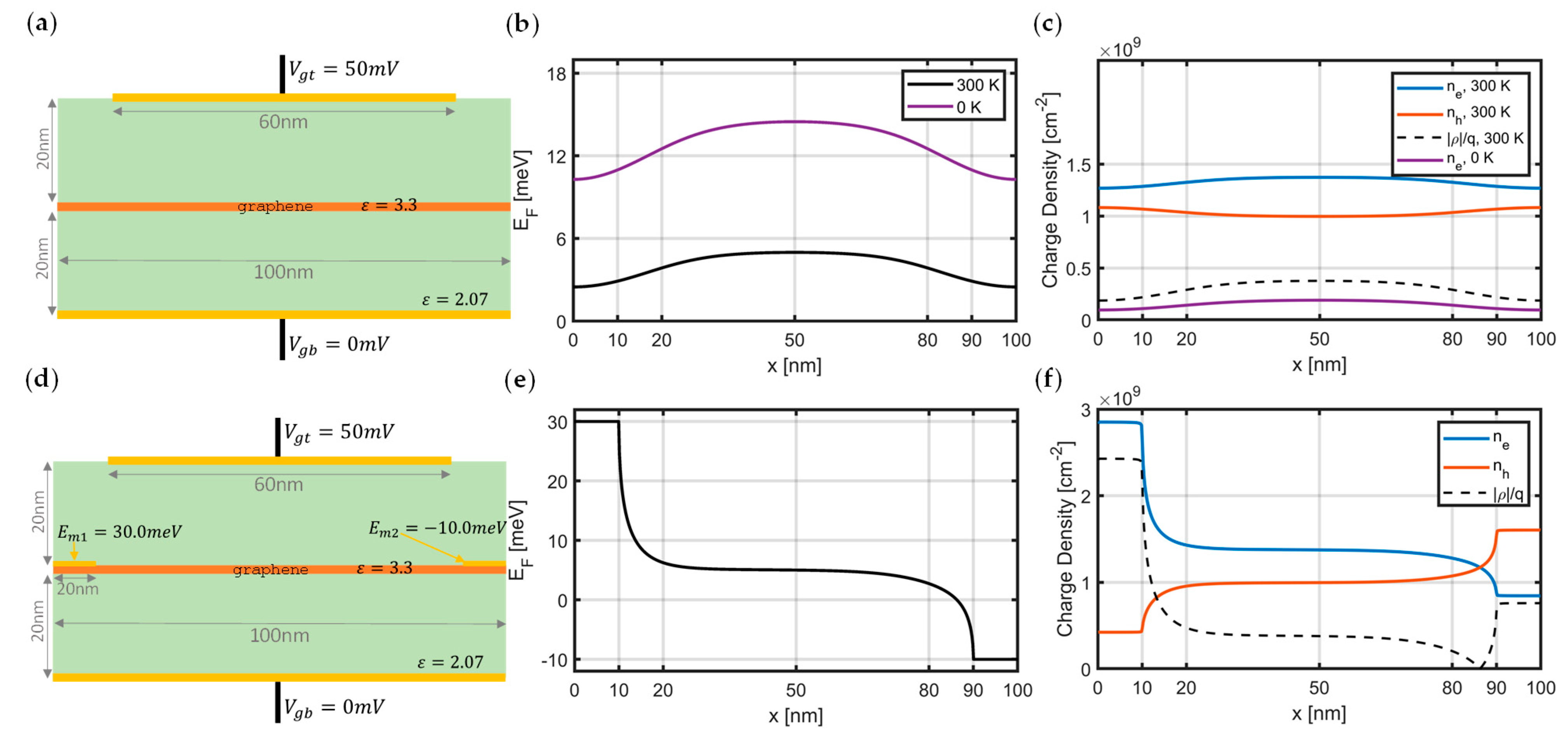
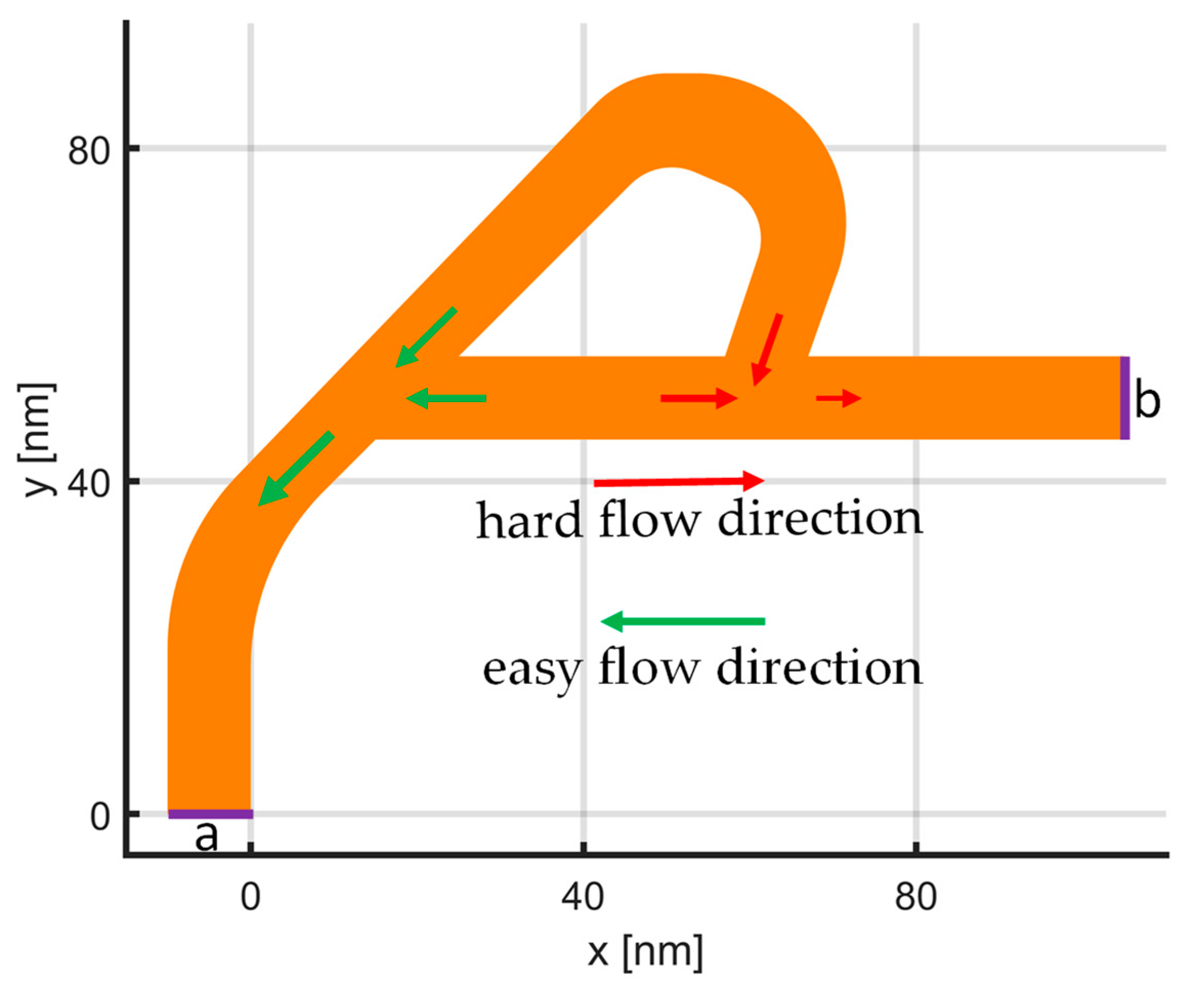
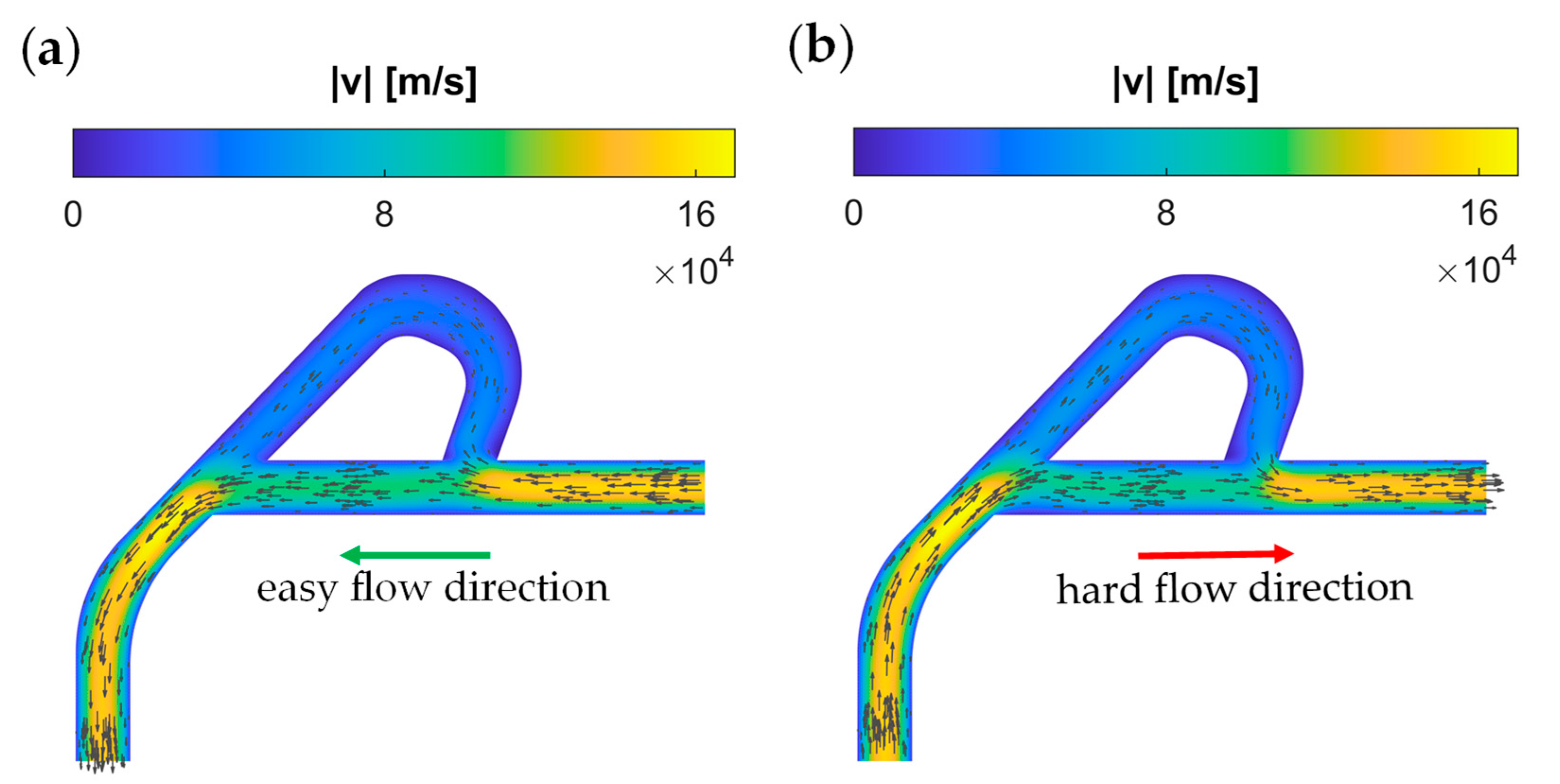
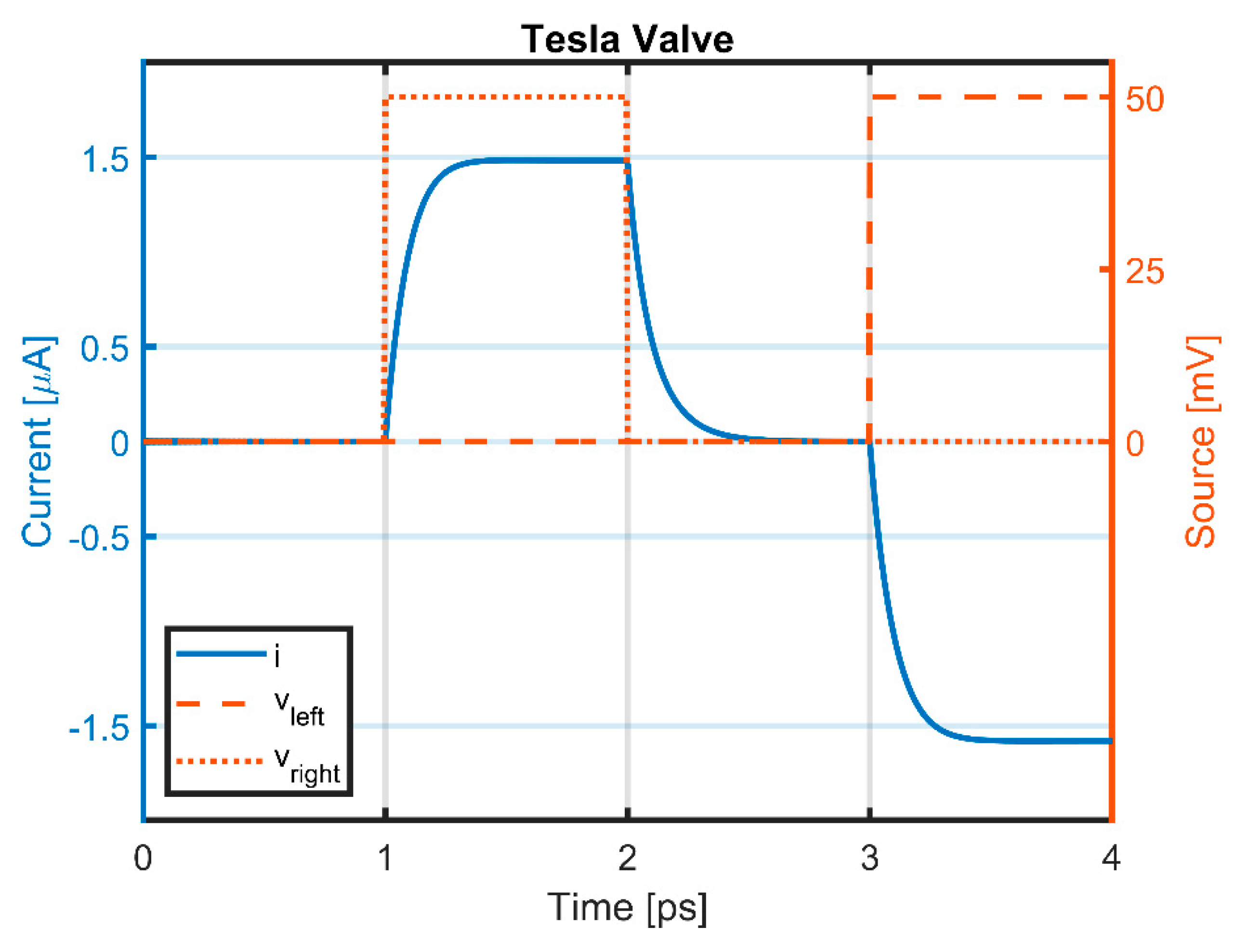
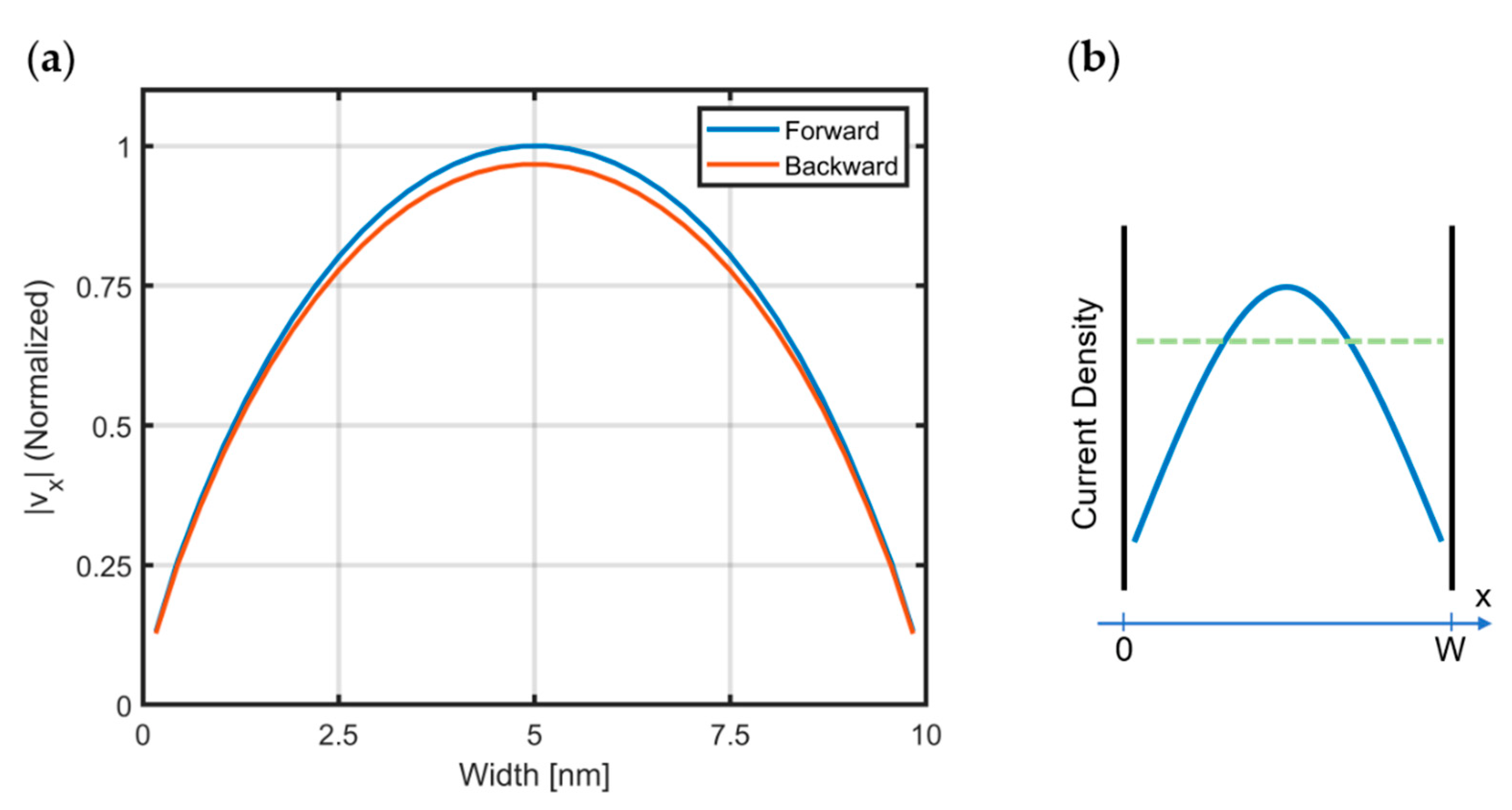
Publisher’s Note: MDPI stays neutral with regard to jurisdictional claims in published maps and institutional affiliations. |
© 2022 by the authors. Licensee MDPI, Basel, Switzerland. This article is an open access article distributed under the terms and conditions of the Creative Commons Attribution (CC BY) license (https://creativecommons.org/licenses/by/4.0/).
Share and Cite
Gungor, A.C.; Koepfli, S.M.; Baumann, M.; Ibili, H.; Smajic, J.; Leuthold, J. Modeling Hydrodynamic Charge Transport in Graphene. Materials 2022, 15, 4141. https://doi.org/10.3390/ma15124141
Gungor AC, Koepfli SM, Baumann M, Ibili H, Smajic J, Leuthold J. Modeling Hydrodynamic Charge Transport in Graphene. Materials. 2022; 15(12):4141. https://doi.org/10.3390/ma15124141
Chicago/Turabian StyleGungor, Arif Can, Stefan M. Koepfli, Michael Baumann, Hande Ibili, Jasmin Smajic, and Juerg Leuthold. 2022. "Modeling Hydrodynamic Charge Transport in Graphene" Materials 15, no. 12: 4141. https://doi.org/10.3390/ma15124141
APA StyleGungor, A. C., Koepfli, S. M., Baumann, M., Ibili, H., Smajic, J., & Leuthold, J. (2022). Modeling Hydrodynamic Charge Transport in Graphene. Materials, 15(12), 4141. https://doi.org/10.3390/ma15124141






